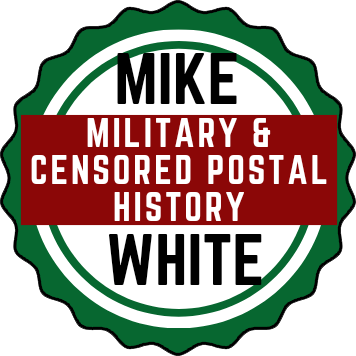South Africa
A Parliamentary Republic sitting at the bottom of Africa and covering almost half a million square miles was a barren land named in 1488 by the Portugals King John 2nd “Cape of Good Hope”, although the mariners called it “Cape of Storms”.
The Dutch in 1652 established a Trading Post & Naval Victualing Station to act as a secure port for Dutch merchantmen running the Europe to Asia route. The British took Dutch settlements as prizes in 1815 after the Napoleonic war, made it a Crown colony because of it’s strategic importance pushing the Boer settlers further inland. The Boers made new settlements on their migration Northwards notably the South African Republic, the Orange Free State & Transvaal. While the British consolidated and established British Bechuanaland, Zululand, Griqualand West & Natal.
Diamonds and Gold were found around 1880 on Boer lands and although the British had tolerated the Boers the new found wealth made them a potential threat and from 1880 to 1902 two Anglo-Boer wars were fought before the British conquered them.
In 1910, Cape Colony, Orange Free State, Natal and Transvaal formed the Union of South Africa that restricted the rights of non-whites leading to in 1948 the Apartheid policies and establishment of the “Homelands” for non-whites. In April 1994 these “Homelands” were incorporated into South Africa.
The first stamps were issued in 1853, a 1d & 4d triangular in shape inscribed Cape of Good Hop. Natal followed with an issue in 1857, the Orange Free State’s first issue was 1868 and Transvaal in 1869.
These four States formed in 1910 the Union of South Africa with a stamp issued to Commemorate Opening of Union Parliament on 4 November 1910 followed by the first definitive issues in 1913 although the provisional issues of the four states were valid until 1938.
WW2 saw the introduction of Wartime economy half size Bantam stamps to conserve paper and these are popular.
-
1943 SOUTH AFRICA – ITALY…WW2 ITALIAN POW.. [23102]
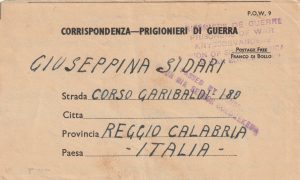 $30.00
Add to cart
More Info...
$30.00
Add to cart
More Info... -
1900 SOUTH AFRICA (BOER WAR) – INDIA..1st Batt. OXFORD REGT.. [23097]
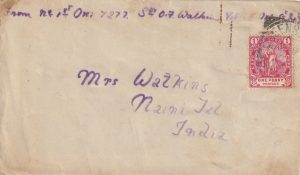 $65.00
Add to cart
More Info...
$65.00
Add to cart
More Info... -
1899 SOUTH AFRICA (PRETORIA) – GB..POW HELD BY BOERS.. [23094]
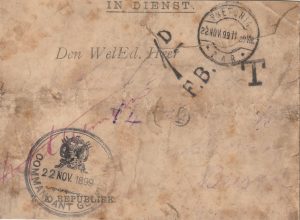 $95.00
Add to cart
More Info...
$95.00
Add to cart
More Info... -
1942 CYPRUS – SOUTH AFRICA (ZULULAND, NATAL)..WW2 CENSORED .. [22971]
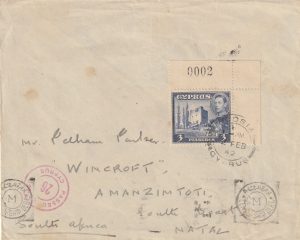 $425.00
Add to cart
More Info...
$425.00
Add to cart
More Info... -
1941 KENYA – SOUTH AFRICA (NATAL)..SOUTH FRICAN FORCES.. [23064]
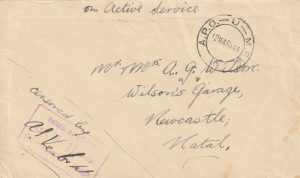 $20.00
Add to cart
More Info...
$20.00
Add to cart
More Info... -
1942 GB…to HMS BIRMINGHAM CAN’T FIND & RETURNED.. [23039]
 $50.00
Add to cart
More Info...
$50.00
Add to cart
More Info... -
1900 SOUTH AFRICA (NATAL) – HMS MONARCH (SIMONS BAY).. [23000]
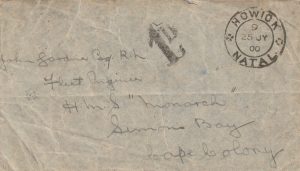 $125.00
Add to cart
More Info...
$125.00
Add to cart
More Info... -
1901 SOUTH AFRICA (BOER WAR) …N.Z. CONTINGENT.. [22823]
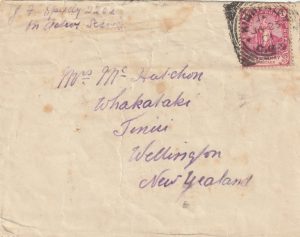 $350.00
Add to cart
More Info...
$350.00
Add to cart
More Info... -
1941 KENYA – SOUTH AFRICA..SOUTH AFRICAN FORCES in EAST AFRICA.. [22816]
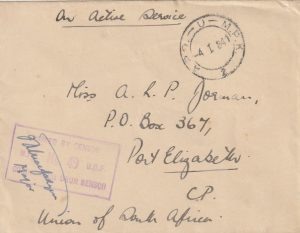 $40.00
Add to cart
More Info...
$40.00
Add to cart
More Info... -
1941 EGYPT…SOUTH AFRICAN FORCES at EL ALAMEIN.. [22815]
 $25.00
Add to cart
More Info...
$25.00
Add to cart
More Info... -
1941 EGYPT – SOUTH AFRICA..WW2 SOUTH AFRICAN FORCES.. [22812]
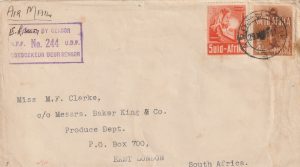 $20.00
Add to cart
More Info...
$20.00
Add to cart
More Info... -
1944 SOUTH AFRICA – USA..DOUBLE CENSORED RED CROSS.. [22788]
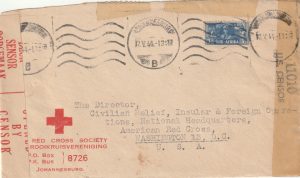 $40.00
Add to cart
More Info...
$40.00
Add to cart
More Info... -
1943 GB – SOUTH AFRICA…WARTIME ECONOMY TWICE USED [22766]
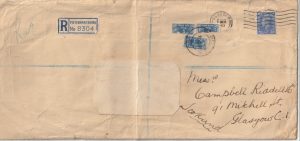 $40.00
Add to cart
More Info...
$40.00
Add to cart
More Info... -
1942 SOUTH AFRICA – GOLD COAST…WW2 ZANO GOLD DREDGING LTD.. [22756]
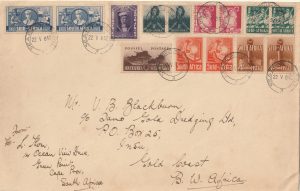 $100.00
Add to cart
More Info...
$100.00
Add to cart
More Info... -
1942 SOUTH AFRICA…WW2 REGISTERED, INTERNAL & PATRIOTIC… [22755]
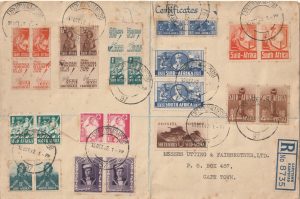 $65.00
Add to cart
More Info...
$65.00
Add to cart
More Info... -
1943 SOUTH AFRICA – GB..RED CROSS SOCIETY…. [22753]
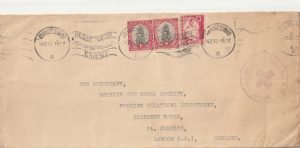 $25.00
Add to cart
More Info...
$25.00
Add to cart
More Info... -
1943 SOUTH AFRICA – ITALY..WW2 POW LETTER SHEET.. [22746]
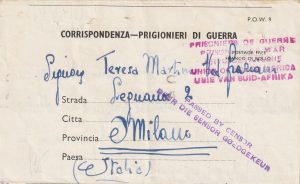 $30.00
Add to cart
More Info...
$30.00
Add to cart
More Info... -
1901 SOUTH AFRICA (TRANSVAAL- AUSTRALIA..N.S.W CONTINGENT to BOER WAR.. [22720]
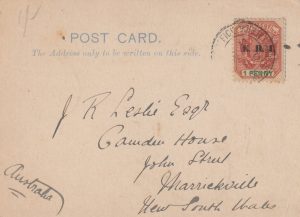 $425.00
Add to cart
More Info...
$425.00
Add to cart
More Info... -
1941 SOUTH AFRICA (KWA ZULU, NATAL…1941 HOSPITAL SHIP “OXFORDSHIRE”..PATRIOTIC & XMAS LABELS.. [22713]
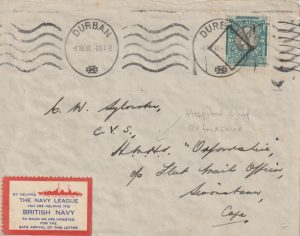 $125.00
Add to cart
More Info...
$125.00
Add to cart
More Info... -
1941 SOUTH AFRICA – GB…1941BRITAIN’S BOMBED CITIES RELIEF FUND ..PATRIOTIC,, [22712]
 $75.00
Add to cart
More Info...
$75.00
Add to cart
More Info... -
1942 SOUTH AFRICA – GB..4d REGISTERED ENV. FOUND OPEN or DAMAGED.. [22711]
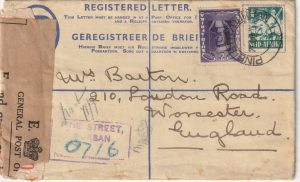 $40.00
Add to cart
More Info...
$40.00
Add to cart
More Info... -
1940 SOUTH AFRICA…WW2 CAPE EXPLOSIVES WORKS… [22710]
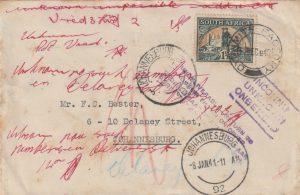 $125.00
Add to cart
More Info...
$125.00
Add to cart
More Info... -
1940 SOUTH AFRICA…1940 PINELANDS NATIONAL WAR FUND..PATRIOTIC.. [22709]
 $75.00
Add to cart
More Info...
$75.00
Add to cart
More Info... -
1941 SOUTH AFRICA – GB…1941 THANKS TO THE BRITISH NAVY ..PATRIOTIC,, [22708]
 $175.00
Add to cart
More Info...
$175.00
Add to cart
More Info...
